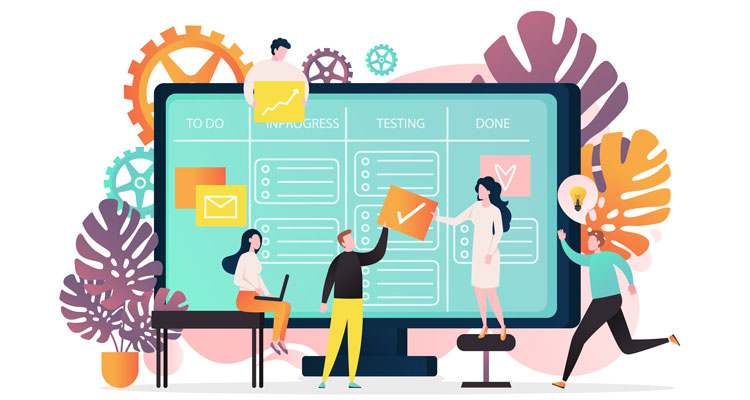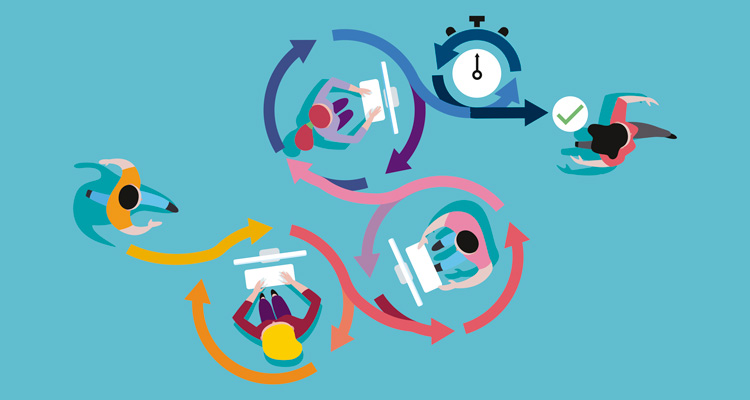
It’s no secret that Kanban boards have become a popular tool to enhance the way work flows within an organization. It has long since been a favorite for operations teams who don’t work well with Scrum, but now there’s been more focus on how Kanban can be used to enhance product development teams as well. Kanban makes it easier for development organizations to adopt a flow-driven product management approach that minimizes uncertainty, facilitates continuous improvement, and drives innovation across the organization.
In this post, we’ll look at why and how more product (and non-product) teams are turning to Kanban and adopting a flow-driven approach to help them work more efficiently. Let’s get started.
Kanban goes hand-in-hand with Agile and Lean practices and principles. For development organizations, combining these two makes it possible to enhance development practices and implement them across the organization––and Kanban is an essential tool that helps organizations facilitate this change. This approach makes it possible for development organizations to create a sustainable culture of innovation and continuous improvement by following three simple steps:
- Amplifying feedback loops.
- Focusing on end-to-end flow.
- Delivering continuous improvement.
Let’s look at all three of these steps more carefully, starting with feedback loops.
Amplifying Feedback Loops
Most businesses have the same overall goal in mind. They want to create products and services that are closely aligned with the needs of their businesses and the needs of the customer. This goal is generally the same, regardless of whether you’re working in IT, product development, or knowledge work. With flow-driven product management, you work to achieve the same goal by amplifying feedback loops. The idea is that amplified and shorter feedback loops make it easier to improve products, allowing you to create a culture of continuous improvement as well. Before we look at how these feedback loops help companies improve, let’s look at the problems they address.
The challenge that a lot of organizations face is uncertainty. They’re not able to deliver continuous improvement because they don’t know…
- How long it takes to develop or implement a product
- How to anticipate problems that teams may encounter along the way
- Whether stakeholders are in agreement on the value of their projects
In other words, they operate in this complex gray area filled with uncertainty and disagreement, and this can inhibit an organization’s ability to continuously improve. Fortunately, the Agile and Lean approach has an answer to this problem––feedback loops. The idea is that shorter feedback loops create more informed teams. Work runs in smaller batches and is pushed downstream for feedback, where it’s then reworked if needed. And all of this is made possible with the help of Kanban. That’s because Kanban makes it easy to slice work into testable chunks designed to flow feedback more quickly. This helps teams work in smaller, quicker batches, which is necessary for reducing the time between feedback and improvement.
What’s more, Kanban is also important for breaking down functional silos. You can use the board to connect teams from all parts of the value stream on one Kanban board, including DevOps.
Being Proactive with Your Developments
Working in small batches is only part of shortening feedback loops. To amplify your feedback loops effectively, you also need to plan ahead, thinking about the downstream phases and how you can prepare for them. This helps with minimizing surprises and uncertainty, so that work flows more smoothly through the value stream.
Do this by talking to people in testing and maintenance before developing your product. Ask them about:
- How they’re going to test your product
- The various elements needed in maintenance to ensure features run smoothly
- What capacity they have to take on the work you’re trying to deliver
With this information handy, you can then start designing your products so they’re more likely to pass acceptance tests on the initial run. You can save a lot of time this way, cutting out unnecessary bottlenecks standing between you and customer feedback.
Focusing on End-to-End Flow
The next step in adopting flow-driven product management is focusing on end-to-end flow. To deliver end-to-end flow, try thinking of the value stream as a giant conveyor belt, then apply flow principles to ensure that work moves smoothly down the line, using Kanban boards to visualize work and optimize flow. Let’s look at how you can do that.
Kanban plays an essential role in helping Agile and Lean organizations visualize their end-to-end flow. But you first need to know how to use your Kanban board effectively. This means adopting a mixture with different layers of Kanban boards, looking at Kanban at the program-level instead of a simplified story-level board. This will help you better understand the status of your projects by letting you visualize how work’s moving upstream and downstream, so that you know what work is flowing into Agile teams and what work is flowing outside of them.
The goal of Kanban isn’t to change the way you’re working, but rather offer you a bigger picture of how processes move through the organization so you can work towards a better flowing end-to-end picture. There are two common approaches to take with Kanban to achieve this.
The first approach is for dynamic teams. It includes:
- A features board that shows the end-to-end picture
- A story board for managing flow at the team level
The features board allows you to see how work is moving through the different teams across the organization, while the story-level board lets you focus on individual teams. The reason this option works well with dynamic teams that change from time to time is because you don’t have to create a new Kanban board for each team whenever the nature of work shifts.
The second approach is for stable teams. Here, you assign a separate features board and a story board to each team. The advantage of this approach is that it makes it easier to track the progress of individual teams, and since the nature of their work doesn’t change over time, you don’t have to worry about constantly creating new Kanban boards.
Delivering Continuous Improvement
The next step in the flow-driven product management cycle is creating a culture of continuous improvement. The primary reason why organizations amplify their feedback loops in the first place is to speed up the improvement process.
One way you can deliver continuous improvement is by going on a WIP diet. The lower the number of works-in-process your teams have, the better equipped they are to deliver more effectively. There are also a number of metrics you can track to measure the effectiveness of your Agile and Lean practices, and how well your organization is continuously improving. You can learn more about that by reading our post on Lean metrics for increasing speed of delivery.
Ultimately, the function of flow-driven product management is to remove the various barriers preventing teams from completing their work. Because the faster work moves through the value stream and receives customer feedback, the quicker teams can improve their products. This is important for not only developing products aligned with the needs of the business and the customers, but also an effective way to prevent overages and reduce unnecessary costs.
Want to learn more about flow-driven product management and how you can use it to empower your organization? Watch our webinar on the topic. If you’re ready to get started, check out Planview AgilePlace. It offers all the tools necessary to optimize your workflow and shorten feedback loops, so that you create a culture of continuous improvement within your organization.






